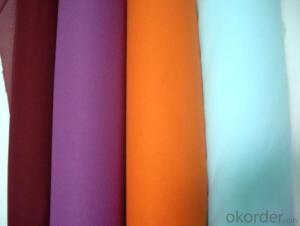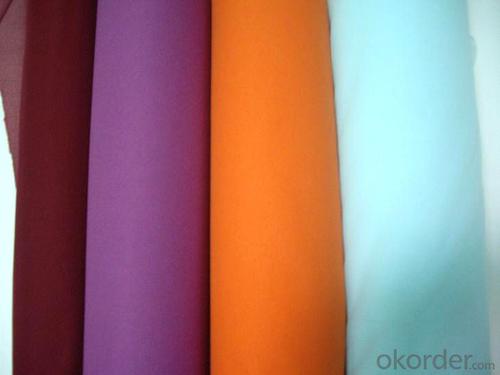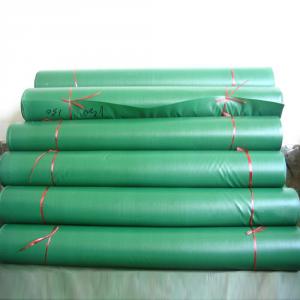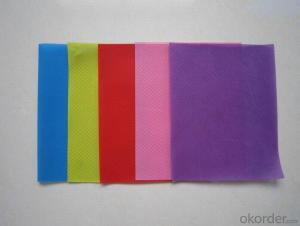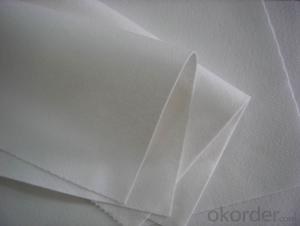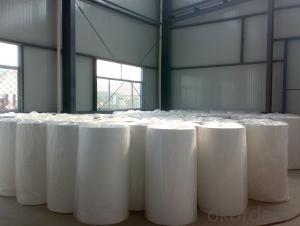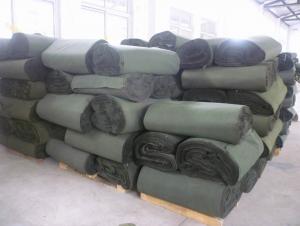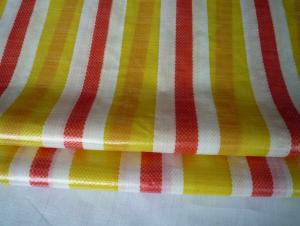polypropylene non woven fabric/Bubble Non woven Fabric roll/PP non woven fabric
- Loading Port:
- Shanghai
- Payment Terms:
- TT OR LC
- Min Order Qty:
- 1000 roll
- Supply Capability:
- 10000 roll/month
OKorder Service Pledge
OKorder Financial Service
You Might Also Like
Specifications
Non woven fabric(chemical bond nonwoven,chemical fabric)
Non woven fabric
Fiber composition: 100% PET,or PET mix Viscose
Width: Below 88 inch(220cm)
Weight:20G-150G square meter
Hand feeling: Soft, Hard,Crisp etc
Color: White,Super white,Black color etc
Item No:2016S,2016H,1020H,1025H,1035H,1050H,1065H
Chemical Bonded Non-woven fabric made of 100% PET,PET mix Viscose material etc,weight from 20-150g/m,width below 220cm,do soft,hard,crisp hand feeling,have white,super white,Black color.The product are widely used for Chef hat material,Handicraft product,clothes interlining,Embroidery etc.
Non woven fabric(chemical bond nonwoven,chemical fabric)
Health - Hygiene & Medical
Surgical Gowns
Gloves
Face Masks
Foot covers
Diapers
Caps
Bedsheets
Curtains
Pillow Covers
Slippers
Packaging
Sleeping Bags
Tarpaulins
Tents
Artificial Leather
Bags for Rice/Sugar etc.
Luggage
Vacuum Cleaner Bags
Tea and Coffee Bags
Buff Pads
Shopping Bags
Agriculture
Crop Covers
Turf Protections
Nursery Over wintering
Weed Control Fabrics
Root Bags
Containers
Capillary Matting
Other types of covers
Furniture Upholstery
Roofing and Tile Underlayment
Acoustical Ceilings
Insulation
House wrap
Pipe wrap
Sofa and Mattress Lining
Shoes & Garments
Coveralls
Pillow cases
Airline Headrests
Interlinings
Clothing and Glove insulation
Bra and Shoulder Padding
ADVANTAGES:
1. Lower labour costs as no weeding maintenance for years;
2. Water seeps through and can conserve soil moisture for improved growing conditions;
3. Air escapes – humidity rises through the mat for a more controlled growing environment;
4. Increase crop yields close to 25% due to improved growing conditions and absence of water stress and competition of nutrients absorption from weeds;
5. Minimises bacteria and fungus problems especially Algae;
6. Strong, woven construction or pressed fibre sheet resists tears and punctures;
7. Resistant to mildew, rot, water, sunlight and most of the agricultural chemicals
8. Fertilizer is applied on the mat, thus helping the owner or estate manager to monitor the progress of manuring;
9. Prevents soil erosion or leaching of soil nutrients or fertilizers applied;
10. Environmental friendly.
FAQ:
Q .What is the material of the non woven fabric ?
A .PP spunbond non woven fabric
Grade A: 100% Polypropylene
Grade B: 90% Polypropylene +10% filling
Q .What about the width of the non woven fabric ?
A .We can cut the fabric as your requirement. Our width of machine is 240cm, so the max of the width is 240cm
Q .What about the color ?
A .Any color is available. You just need to give me the Panton Num or send me your sample. Then we will make the color samples to you for approve
Q .What about the GSM ?
A .The thinnest of the fabric that we can produce is 9g, and the thickest is 250g. Normally the fabric that used in bag making is 50-100g, the agricultural used is 17-50g, the home used fabric is 40g and so on...
Q .What about the delivery time ?
A .We can finish the production in 2-3 days (40ft HQ)
Q .What about the price ?
A .We are the factory of the PP nonwoven fabric, We can supply you with good quality and favorable price
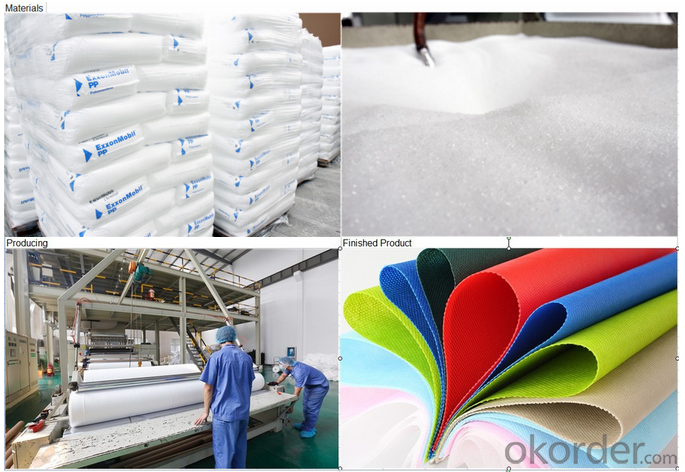
- Q: Textile industry after finishing what pollution, especially air pollution
- Big talk about the air side of the textile enterprises are usually in the air nitrogen and sulfur oxides will be excessive even if you can escape the environmental monitoring brigade check is usually no night to steal because the air pollution handling costs are too large and too much and I can clearly say Just can smell the odor can be concluded that serious pollution
- Q: What are the test tests for the color fastness of textiles?
- 13, resistant to non-chlorine color fastness 14, resistance to chlorine color fastness 15, acid color fastness 16, alkali color fastness 17, water-resistant color fastness 18, resistance to organic solvent friction color fastness
- Q: Lin is what kind of textile
- Textile fiber 1, the definition: fiber is a natural or synthetic filamentous material, textile fiber is used to textile fiber. 2, textile fiber Features: textile fiber has a certain length, fineness, flexibility, strength and other good physical properties
- Q: What is the anti-perspiration finishing of textiles?
- At the same time, the fabric hydrophilic surface in the hydrophilic, the corresponding waterproof surface can not see the watermark. At present in the knitted fabric on the anti-perspiration finishing more mature, in the weight of the lower woven fabrics, especially light-colored anti-perspiration effect is not particularly ideal
- Q: How to make fibrous textiles for waste plastic bottles?
- Plastic bottle is a treasure, you can also make quilts, sofas, mattresses and other home textiles fillers, can also be used to make carpets, imitation and down products
- Q: Cotton chemical fiber textile, hemp textile, wool textile, silk silk textile industry, the difference between the four
- From 2000 to this year, the national cotton acreage, yield and cotton market supply and demand relationship, the rapid development of China's cotton industry, from the cultivation of surface cross, production and enterprise scale have unprecedented unprecedented development, but also to the textile industry development into power, Promote China's textile industry into a new period of development, the international competitiveness increased significantly
- Q: What is the step in the textile fabric
- With the words and deeds, the attitude represents the company, so with the business units to deal with the corresponding business process, we must grasp the basic principles, pay attention to words and deeds, attitude neither overbearing nor humble. It is strictly forbidden to have any excitement to the client (or the customer's merchandiser) for any subjective or objective reasons. Processing business process can not arbitrarily overweight position, there are problems in time to ask the company to decide.
- Q: What are the classification of the textile?
- Warp, warp, warp density - the length of the fabric; the yarn is called the warp; the number of yarns in the 1 inch yarn is the density (warp density);
- Q: What is the specialty of textile science and engineering?
- Mainly to study how to use mechanical, physical, chemical and other high-tech means to meet the various fields and various functional requirements of the processing and performance evaluation of textiles.
- Q: What are the products produced by the textile mill?
- From the ingredients that have: cotton, wool, silk, linen and chemical fiber, man-made fibers (viscose fiber).
Send your message to us
polypropylene non woven fabric/Bubble Non woven Fabric roll/PP non woven fabric
- Loading Port:
- Shanghai
- Payment Terms:
- TT OR LC
- Min Order Qty:
- 1000 roll
- Supply Capability:
- 10000 roll/month
OKorder Service Pledge
OKorder Financial Service
Similar products
Hot products
Hot Searches
Related keywords
